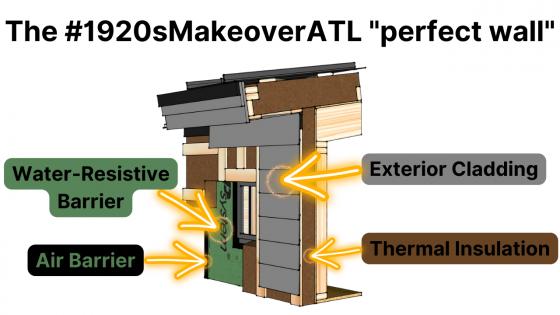Green Building Community
The “Perfect Wall” defined and demonstrated
Posted by: Matt Hoots // Rate It Green Admin

We keep using the term “perfect wall” when describing the various control layers on the #1920sMakoverATL deep enegy retrofit and learning house. This concept does deserve to be unpacked since it sounds like I am stating that a wall is perfecting level or plumb.
What is the “perfect wall”?
The term "perfect wall" refers to an energy-efficient wall system that provides optimal control of heat, air, moisture, and vapor in a building. This concept was developed by building science experts as a way to create an ideal wall system that maximizes energy efficiency and reduces the risk of moisture-related problems.
The “perfect wall” has four main control layers
-
Exterior cladding: This layer protects the wall from external moisture and wind-driven rain. It can also provide a decorative finish to the building. The cladding should be durable, weather-resistant, and properly installed to prevent moisture intrusion.
-
Water-resistive barrier: This layer is installed behind the exterior cladding and provides a secondary layer of protection against moisture intrusion. It should be vapor-permeable to allow moisture to escape and prevent the buildup of moisture in the wall.
-
Air barrier: This layer is typically installed on the interior side of the wall and prevents air leakage into or out of the building. Most builders that use the "perfect wall" assembly install the air barrier on the outside of the sheathing. It helps to improve energy efficiency and prevent the intrusion of outdoor pollutants and allergens. The air barrier should be continuous and properly sealed to prevent air leakage, which contains water vapor.
-
Thermal insulation: This layer provides thermal resistance and helps to maintain a comfortable indoor temperature. It should be properly installed and have sufficient thickness to achieve the desired level of thermal resistance. This is installed as a continuous layer on top of the "air barrier" and "water-resistant barrier"
Combining these four control layers allows the perfect wall system to provide optimal heat, air, moisture, and vapor control, resulting in a highly energy-efficient and durable building envelope. These are all covered in the international residential code and are code compliant as this method can exceed the energy code in most cases.
Examples of the control layers on the #1920sMakeoverATL
I like to keep things simple, so we combined some control layers. We used the Zip System for the “Water-resistant membrane” and the “Air Barrier.” To prove that the zip panels and zip liquid flash were able to act as both, we ran a blower door on the sheathing. We were surprised to see that the liquid flash alone was able to make the house Passive House compliant with regard to the maximum air leakage requirement. We had a measurement of only .3 ACH50 before additional layers were added to the inside, which should reduce it even more.
We are adding the insulation to the outside of the zip system sheathing for a continuous installation with minimal thermal bridging. Traditional insulation is installed in between the studs, which reduces the overall R-value of the wall since wood is 400% less effective at insulating that insulation. We are using ROCKWOOL since it is water resistant and does not fail like fiberglass insulation when wet.
The final layer is fiber cement siding which prevents the bulk water from getting to the other layers of the house.
This perfect wall assembly is designed for all six sides of the house. We added the insulation and zero perm membrane on top of the insulation before we poured the slab. The ROCKWOOL insulation will be installed on the roof before the metal roofing is installed.
If you'd like to learn more about proper air sealing and insulation, and weatherization, check out these related topics:
- Pros and Cons of an airtight house
- Why Air Sealing and Insulation are Both Essential
- What is ACH50, and why does it matter?
- What is a "water resistant barrier" (WRB), examples and misconceptions
- 50% of the "Perfect Wall" Control Layers with One Product
And stay tuned for more information about proper ventilation and optimizing comfort and indoor air quality in airtight homes. You can also always visit the #1920sMakeoverATL page for information related to this exciting project.
Sources for additional reading:
-
"The Perfect Wall: An Affordable, Sustainable Solution" by Building Science Corporation
-
"Building Science for Building Enclosures" by Joseph Lstiburek
-
"Green Building Illustrated" by Francis D.K. Ching and Ian M. Shapiro
Please be kind and respectful!
Please make sure to be respectful of the organizations and companies, and other Rate It Green members that make up our community. We welcome praise and advice and even criticism but all posted content and ratings should be constructive in nature. For guidance on what constitutes suitable content on the Rate It Green site, please refer to the User Agreement and Site Rules.
The opinions, comments, ratings and all content posted by member on the Rate It Green website are the comments and opinions of the individual members who posts them only and do not necessarily reflect the views or policies or policies of Rate It Green. Rate It Green Team Members will monitor posted content for unsuitable content, but we also ask for the participation of community members in helping to keep the site a comfortable and open public forum of ideas. Please email all questions and concerns to admin@rateitgreen.com

